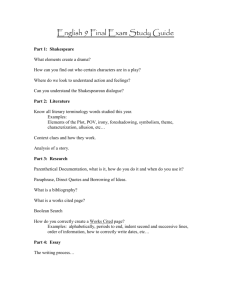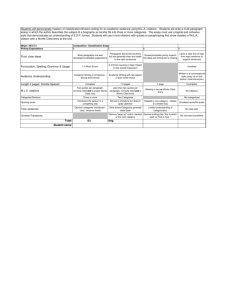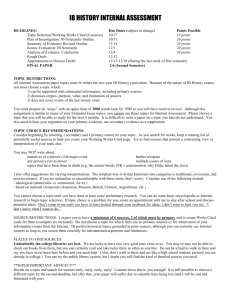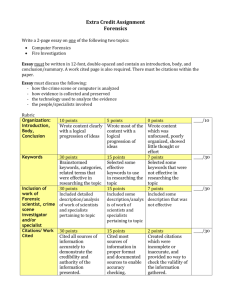MLA Formating
advertisement
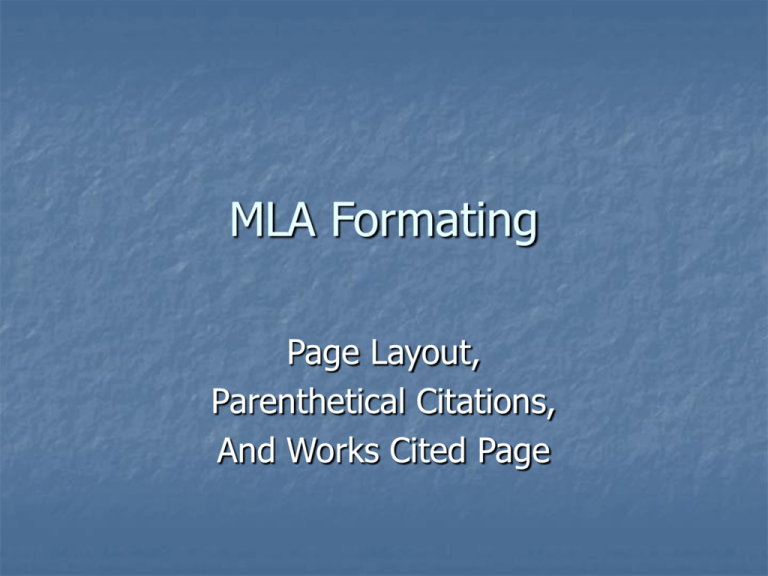
MLA Formating Page Layout, Parenthetical Citations, And Works Cited Page MLA Format Overview 12-point font size Times New Roman is an acceptable style of font (nothing “funky”) Double-spaced Black ink 1-inch margins all around (top, bottom, right, and left) Header-all pages Name-Heading, double spaced 1” Last name page number Teacher-First page only Class Date 1” Center Title (Double space between the title and first paragraph) Indent 1/2” or 5 spaces The whole paper is double spaced. Do not skip extra lines between paragraphs. 1” 1” Parenthetical Citations When Should You Use Parenthetical Citations? When quoting any words that are not your own When summarizing facts and ideas from a source Quoting means to repeat another source word for word, using quotation marks Summarizing means to take ideas from a large passage of another source and condense them, using your own words When paraphrasing a source Paraphrasing means to use the ideas from another source but change the phrasing into your own words What are Parenthetical Citations Act as a “flag” or “marker” to help reader find full citation information on Works Cited page Placed in parentheses, usually after direct quotes or paraphrased or summarized segments of information Information inside parentheses depends upon type of source used Example Citations Usually author’s last name and page number (no first name, and no comma between last name and page number) Example: (Smith 32). Or (Smith 32)? Note that punctuation comes after parentheses, not before (and certainly not both!) More Examples NOVEL or ESSAY—Use author’s last name and page number. If no author is given, use title and page number. (Faulkner 234). (“Short Story” 13). (Novel 35). (“Article Title” 2). Still More Examples Sometimes more information is necessary More than one author with the same last name (W. Wordsworth 23); (D. Wordsworth 224) More than one work by the same author (Joyce, Portrait 121); (Joyce, Ulysses 556) Handling Long Quotations David becomes identified and defined by James Steerforth, a young man with whom David is acquainted from his days at Salem House. Before meeting Steerforth, David accepts Steerforth’s name as an authoritative power: There was an old door in this playground, on which the boys had a custom of carving their names. . . . In my dread of the end of the vacation and their coming back, I could not read a boy’s name, without inquiring in what tone and with what emphasis he would read, “Take care of him. He bites.” There was one boy—a certain J. Steerforth—who cut his name very deep and very often, who I conceived, would read it in a rather strong voice, and afterwards pull my hair. (Dickens 68) For Steerforth, naming becomes an act of possession, as well as exploitation. Steerforth names David for his fresh look and innocence, but also uses the name Daisy to exploit David's romantic tendencies (Dyson 122). Citing Poetry When citing lines from a work of poetry, use line numbers. If more than one line of poetry is quoted, use a hyphen between line number range in in-text citation. (4-6). (13). If using more than one work by the same author, use poem’s title and line numbers for clarity. Citing the Internet CORRECT electronic/internet source citations: (Smith 32). (“Article Title” 4). (Smith). (“Article Title”). INCORRECT electronic/internet source citation: (http://www.yahoo.com). (www.authors.text.com). Works Cited Page A complete list of every source that you make reference to in your essay If it is cited in your essay, it needs to be on your works cited page. If it is on your works cited page, it needs to be cited in your essay. Provides the information necessary for a reader to locate and retrieve any sources cited in your essay. Works Cited Page Rules Alphabetically organized by author’s last name or title (if no author is given for a source) For each source entry, all lines AFTER the first are indented. (This can be accomplished by using Tab on the keyboard or using the hanging indent feature on the margin ruler) 1/2” 1” Last name page number Center Title 1” 1” (Double space between the title and first entry) Begin each entry flush with the left margin. Indent 1/2” or 5 spaces If an entry runs more than one line, indent. Double space entire list, both between and within entries. 1” A Sample Works Cited Page Smith 12 Works Cited Dickens, Charles. Bleak House. 1852-1853. New York: Penguin, 1985. ---. David Copperfield. 1849-1850. New York: Houghton Mifflin Company, 1958. Miller, J. Hillis. Charles Dickens: The World and His Novels. Bloomington: U of Indiana P, 1958. Zwerdling, Alex. “Esther Summerson Rehabilitated.” PMLA 88 (May 1973): 429-439.
